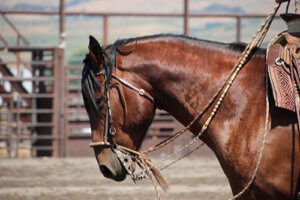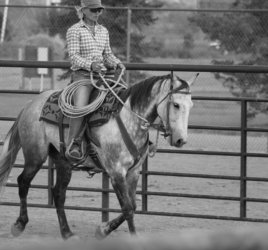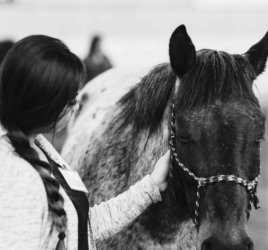Horses have always been a part of his life. From the age of 12 Buck Brannaman has been starting horses, before that he was an accomplished trick roper. The past 35 years Buck has lived most of the year on the road crossing the United States, visiting Canada, Europe, Australia, New Zealand and even Japan sharing his experience and helping people better understand how to get along with their horses. In 2011 the film Buck documenting Bucks life and work, launched to critical acclaim at the Sundance Film Festival.
Buck is a leader in the horsemanship field and I have watched his progression as a teacher through the past dozen or so years. I have always said to be good with horses you have to be great with people, Buck is both. My annual trek, with and without horses, down to listen, learn and ride with him in Montana has become part of my own professional development.
After a long day in the sun, with temperatures well into the mid 30sC, as is typical of his good nature Buck agreed to answer a few questions.
This is our conversation:
NL- What have horses taught you, about working with people?
 BB – Well, really being incremental in terms of advancing the horse or getting them to understand you. The smaller the pieces you can break it down into. The better chance the horse has at getting it sorted out what you’d like him to do.
BB – Well, really being incremental in terms of advancing the horse or getting them to understand you. The smaller the pieces you can break it down into. The better chance the horse has at getting it sorted out what you’d like him to do.
It took me a while to figure out that I really I had to be good about that doing that with people. Breaking it into smaller pieces. So they could wrap their brain around it and then eventually bring all the pieces together. All of a sudden, it is a dance. It doesn’t seem like a dance at first. It seems like random pieces but that’s the only way a person can learn it sometimes.
I used to make things too complicated. Yet I was really thorough with every detail, but it was too many details at once to absorb. Being incremental really makes a difference.
NL – On your journey you talk often about the influence Ray Hunt and Tom Dorrance had on you.
Is there one thing that they said that made a huge difference, so the pieces started to fall together?
BB – No, I don’t think there was a moment of epiphany. It’s really the light just starts shining a bit brighter over time. There isn’t any one moment in time, it’s a million moments over 30 years.
—–
NL- Do you find as you explain things better, you have those incremental moments that help yourself too?
BB – No, but I’ve heard people say “Well gosh when I started trying to teach this or that, explaining things to others it made me easier for me to understand.” Because you become more thorough and pay more attention to the details.
That happens when you are very early on in teaching. When you’re 35 years into it, I know what I am working on to get better at, on my own journey with the horses. The things I’m working on I can’t even talk about it. It wouldn’t do them any good at their level it would only get them lost. But it makes perfect sense to me where I am in this.
The downside is all my teachers have passed away, it’s pretty lonely. I don’t have that person I can talk with anymore, I have plenty of people to teach. But to be able to talk to someone like Ray or Tom, I don’t have that person to talk to anymore, it’s an empty place that can’t be filled, but at least I had it for a good number of years before that was gone.
—–
 NL- You read a fair bit don’t you? Do you find some of that support in other’s words?
NL- You read a fair bit don’t you? Do you find some of that support in other’s words?
BB – I do. Some of it. It’s bits and pieces, those little gems that you pick up and there. I still have the horse. The horse will sure let me know if I’m totally out of line with what I’m doing or if I will be right on track. If you’re humble enough to listen. Because you might not always like what you hear, but it’s truth and it might be a little hard to take sometimes. You sometimes have to check yourself and make a new plan.
—–
NL- As you’ve advanced as a teacher – to you find your students give you that feedback.
BB – What the students are able to accomplish is a reflective on how I’m able to get the point across. Some folks are going to have more talent than others. Like anything. I just want them to get better, at what ever place they are working from. Not everyone is going to be a prodigy, that’s just being real, but everyone can get better.
—–
NL – There was one thing you said yesterday with regards to presence. “Why would he move with the presence you have?”
Have you noticed those who connect well with the horse and how well they adapt to what you are trying to teach have good presence?
BB- Sure even recognizing presence or the lack of it, that’s primal. That is something that everyone has whether they know it or not or whether they are aware of it. The human can change that, you can have a human with very little presence but with confidence and knowledge, those two go hand in hand – that person who is timid and very little confidence you can change that the presence. Because the presence has everything to do with how you feel about yourself.
You’ll have a stockdog without much presence and he might not ever. but the human theoretically is supposed to be the smart one and the human can can change and develop something that will be of great value to them, if they work at it. The presence is everything.
—–
NL – If there is one thing humans could get better at, as a result of their interactions with horses.
BB – That’s really simple. It’s three words, I learned it from Ray a long time ago. Observe, Remember & Compare. That’s it! You can figure out anything if you just remember those three words. You can figure out anything!
Horsemanship is an art.
![By The original uploader was Snowdog at Italian Wikipedia [GFDL (http://www.gnu.org/copyleft/fdl.html) or CC-BY-SA-3.0 (http://creativecommons.org/licenses/by-sa/3.0/)], via Wikimedia Commons](https://upload.wikimedia.org/wikipedia/commons/8/82/Sistina-interno.jpg) BB- Horsemanship is an art and deserves every bit the respect of any other art – whether it’s music, painting, sculpting, poetry, it is an art and people who respect it treat it that way.
BB- Horsemanship is an art and deserves every bit the respect of any other art – whether it’s music, painting, sculpting, poetry, it is an art and people who respect it treat it that way.
I’m pretty sure if you got a chance to talk to Michelangelo toward the end of his life and asked him if there any chance he could get any better. He’d say “of course I could.” yet he was amazing – you’d look at his work and think “How could you possibly do any better?” I bet he would have told you “Absolutely I could do better.” He could probably take you into the Sistine Chapel and point you to a spot and say “You see that part up there I don’t like that, I never have liked it. I sure wish I could do that again.”
That is the pursuit of the art.
and with that I had exactly what I needed.
Buck headed off for an icey cold Modelo, his words. Emily & I well we stuck around for a while so I could let Emily learn to drive a standard. Emily learned the clutch…. Well it’s all about feel too.
Nancy Lowery has been blogging about her Leadership Learning through Horsemanship Experiences for over ten years. This series began as “One Foot in the Arena” to explore what other leaders in Calgary have learned about their own leadership through their relationships with horses.
To explore how a day with horses can complement your Leadership Training programs Nancy would love to hear from you.



